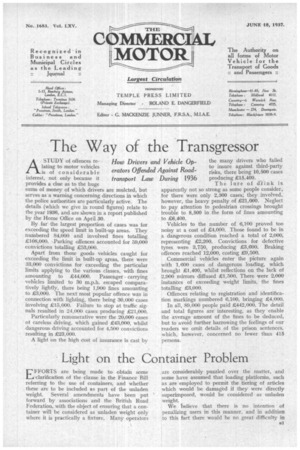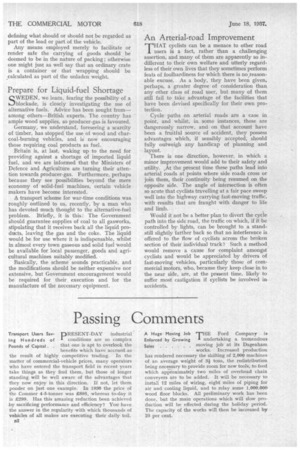Light on the Container Problem
Page 35

Page 36

If you've noticed an error in this article please click here to report it so we can fix it.
UFFORTS are being made to obtain some , V clarification of the clause in the Finance Bill referring to the use of containers, and whether these are to be included as part of the unladen weight. Several amendments have been put forward by associations and the British Road Federation, with the object of ensuring that a container will be considered as unladen weight only where it is practically a fixture. Many operators are considerably puzzled over the matter, and some have assumed that loading platforms, such as are employed to permit the tiering of articles which would be damaged if they were directly superimposed, would be considered as unladen weight. We telieve that there is no intention of penalizing users in this manner, and in addition to this fact there would be no great difficulty in defining what should or should not be regarded as part of the load or part of the vehicle. Any means employed merely to facilitate or render safe the carrying of goods should be deemed to be in the nature of packing; otherwise one might just as well say that an ordinary crate is a container or that wrapping should be _calculated as part of the unladen weight.
Prepare for Liquid-fuel Shortage SWEDEN, we learn, fearing the possibility of a blockade, is closely investigating the use of alternative fuels. Advice has been sought from— among others—British experts. The country has ample wood supplies, so producer-gas is favoured. Germany, we understand, foreseeing a scarcity of timber, has stopped the use of wood and charcoal-burning vehicles, and is now encouraging those requiring coal products as fuel. Britain is, at last, waking up to the need for providing against a shortage of imported liquid fuel, and we are informed that the Ministers of Defence and Agriculture are turning their attention towards producer-gas. Furthermore, perhaps because they see possibilities beyond the mere economy of solid-fuel machines, certain vehicle makers have become interested. A transport scheme for war-time conditions was roughly outlined to us, recently, by a man who has devoted much thought to the alternative-fuel problem. Briefly,, it is this: The Government should guarantee supplies of coal to all gasworks, stipulating that it receives back all the liquid products, leaving the gas and the coke. The liquid would be for use where it is indispensable, whilst in aimost every town gaseous and solid fuel would be available for local passenger, goods and agricultural machines suitably modified. Basically, the scheme sounds practicable, and the modifications should be neither expensive nor extensive, but Government encouragement would . be required for their _ execution and for the manufacture of the necessary equipment. An Arterial-road Improvement THAT cyclists can be a menace to other road .I. users is a fact, rather than a challenging assertion, and many of them are apparently so indifferent to their own welfare and utterly regardless of their own lives that they sometimes perform feats of foolhardiness for which there is no reasonable excuse. As a body, they have been given, perhaps, a greater degree of consideration than any other class of road user, but many of them still fail to take advantage of the facilities that have been devised specifically for their own protection. Cycle paths on arterial roads are a case in point, and whilst, in some instances, these are dangerously narrow, and on that account have been a fruitful source of accident, they possess advantages which, if sensibly accepted, should fully outweigh any handicap of planning and layout. There is one direction, however, in which a minor improvement would add to their safety and utility. At the present time these paths lead into arterial roads at points where side roads cross or join them, their continuity being resumed on the opposite side. The angle of intersection is often so acute that cyclists travelling at a fair pace sweep well into the highway carrying fast-moving traffic, with results that are fraught with danger to life and limb.
Would it not be a better plan to divert the cycle path into the side road, the traffic on which, if it be controlled by lights, can be brought to a standstill slightly farther back so that no interference is offered to the flow of cyclists across the broken section of their individual track? Such a method would remove a cause for complaint amongst cyclists and would be appreciated by drivers of fast-moving vehicles, particularly those of commercial motors, who, because they keep close in to the near side, are, at the present time, likely to suffer most castigation if cyclists be involved in. accidents.




























































































